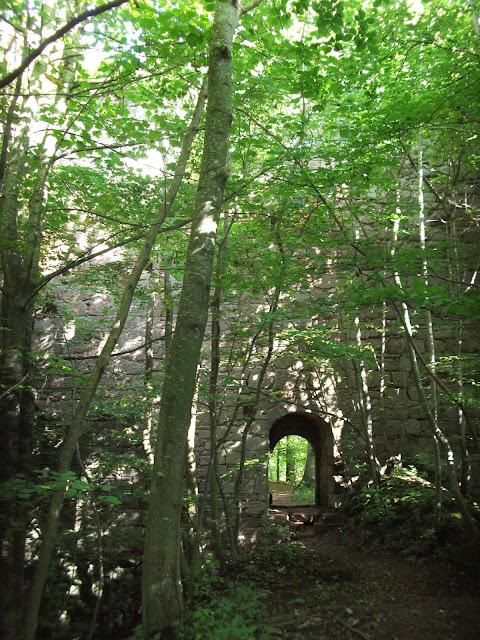 |
| Woodcut of Yester Castle tower from 1814 |
Such a clear blue day, all sunny, all through the air, and filtering through the trees, all the golden sunlight and no clouds and no wind just the stillness and the light and warmth and so glad to be out early in the morning, catching this special time, this special light.
To Goblin Ha’ we were truly bound, the underground Hall of Yester Castle. I had no idea where it was, I just sat in the back of the car once we had met up, while the others unfolded maps and pointed to this road or this path and yes, if we take this turning along a narrow back road, we should find a way of reaching it, there’s a path of sorts, that leads to the wood...by the way – to begin with, this path skirts a golf course…
We come across the ruins suddenly for the wood is thick with trees. The pink stone ruins of the high tower are magnificent. The tower stretches up like a stone lamp gleaming in the sunlight, through the treetops, to the sky. The carved stonework high up is still visible. My picture doesn’t catch the detail but there are excellent ones on this website.
And what about the so-called ‘Goblin Ha’?’ which, according to local lore, could only have been built so quickly with the help of dark demonic forces such as a team of goblins?
According to the same website (where you can read all the historical details of various battles of centuries and the history of the castle ) Yester Castle was first built by the Norman, Hugo de Giffard, in the twelfth century and continued by his heirs in the thirteenth. The South East Tower (which we came across first on the path) was built in the fifteenth century when ownership of the castle had passed to the Hay family. At the same time the old thirteenth century Keep was demolished and a huge wall was built around the hill site of the castle. But the underground cavern below the Keep (known as Goblin Ha’) was preserved.
There are foundation stones all around the tower for several metres, showing it was once a vast complex of buildings. History, or at least its stonework, sinks into the ground, trees grow between the stones of buildings and then their roots take over, entwining around the stones and peeling them away from each other. So vegetation screens, hides and carefully disassembles the work of previous centuries. Then there are the people who take the loosened stones to use for their own building work, clearing more space, more trees grow, and the dilapidation (from the Latin for stone, ‘lapidus’, so we have the undoing, the prising apart, the loosening, or the removal of stones from their original construction) continues. First built by the Norman, Hugo de Giffard, in the twelfth century and continued by his heirs in the thirteenth, what is astonishing (to me) is that so much of the construction remains.
It is not just trees that wind and insinuate themselves and around the ruins, but stories do as well. Like Michael Scott, known as ‘the Wizard’, (who supposedly cleft the Eildon Hills in the Scottish Borders with the power of his magic, turning one hill into three) those with power and/or education, those who came from elsewhere or who had travelled in (then) distant lands (Michael Scott studied in the great universities of Spain and Italy) rumours circulate about these people, and their powers and purposes. For some reason, these rumours often involve association with the Devil or his lesser minions; it would seem that in the popular imagination, the powers that come with learning (or with strangers from elsewhere who have been granted power and land by the rulers) may have dark origins.
From the South East Tower you walk on towards the huge (over 9 metres high) wall, glowing in the sunlight in shades of pale and darker pinkish purple. Considering how many centuries it has stood there, it is remarkably preserved. If you go down a few stone steps you can go right up to two low down pointy-arched barred windows set in the wall. These are the windows of the underground cavern itself (Goblin Ha’).
To reach the cavern, you then go back up the steps and walk through the Postern Gate in the wall,
continue for several metres, and then follow the path that doubles back, steeply downhill. And there is the entrance to the Hall. Looking inside, you can only see darkness. The light from my phone is only strong enough to bring pale visibility to a few stones in front of my feet. But there is a smudge of light ahead, the tunnel ends, and we enter the cavern.
The small amount of light comes from the two arched and barred windows that we first saw from the outside, and which now give a view out onto the wooded hillslope. And once our eyes have adjusted we can make out the remarkable, high vaulted ceiling.
To me the Hall felt more like a place of sanctuary than a demon infested den. And though it is very dark, with only a little natural light filtering through the windows, the beautiful vaulted roof is more reminiscent of a chapel.
Afterwards on the way to the village of Gifford and the restaurant (also called Goblin Ha’) we picked crab apples hanging in profusion from the trees by the roadside. We drove back via Soutra Aisle, church ruins on the mediaeval site of the once vast hospital, near Dere Street, the Roman road. High on the hilltop, there's a view out north east, over to the sea.
And when I got home, in the sky, there were four trails from four planes flying in parallel formation across the huge feathery clouds against a backdrop of blue.









Comments